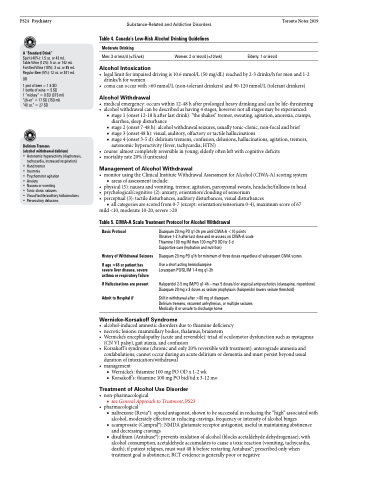Page 1188 - TNFlipTest
P. 1188
PS24 Psychiatry
Substance-Related and Addictive Disorders
Toronto Notes 2019
Table 4. Canada’s Low-Risk Alcohol Drinking Guidelines
A “Standard Drink”
Spirit (40%): 1.5 oz. or 43 mL
Table Wine (12%): 5 oz. or 142 mL Fortified Wine (18%): 3 oz. or 85 mL Regular Beer (5%): 12 oz. or 341 mL
OR
1pintofbeer=1.5SD 1bottleofwine=5SD
1 “mickey” = 8 SD (375 ml) “26-er” = 17 SD (750 ml) “40oz.”=27SD
Delirium Tremens
(alcohol withdrawal delirium)
• Autonomic hyperactivity (diaphoresis,
tachycardia, increased respiration)
• Hand tremor
• Insomnia
• Psychomotor agitation
• Anxiety
• Nausea or vomiting
• Tonic-clonic seizures
• Visual/tactile/auditory hallucinations
• Persecutory delusions
Moderate Drinking
Men: 3 or less/d (≤15/wk)
Alcohol Intoxication
Women: 2 or less/d (≤10/wk)
Elderly: 1 or less/d
• legallimitforimpaireddrivingis10.6mmol/L(50mg/dL)reachedby2-3drinks/hformenand1-2 drinks/h for women
• comacanoccurwith>60mmol/L(non-tolerantdrinkers)and90-120mmol/L(tolerantdrinkers)
Alcohol Withdrawal
• medicalemergency:occurswithin12-48hafterprolongedheavydrinkingandcanbelife-threatening • alcoholwithdrawalcanbedescribedashaving4stages,howevernotallstagesmaybeexperienced:
■ stage 1 (onset 12-18 h after last drink): “the shakes” tremor, sweating, agitation, anorexia, cramps, diarrhea, sleep disturbance
■ stage 2 (onset 7-48 h): alcohol withdrawal seizures, usually tonic-clonic, non-focal and brief
■ stage 3 (onset 48 h): visual, auditory, olfactory or tactile hallucinations
■ stage 4 (onset 3-5 d): delirium tremens, confusion, delusions, hallucinations, agitation, tremors,
autonomic hyperactivity (fever, tachycardia, HTN)
• course:almostcompletelyreversibleinyoung;elderlyoftenleftwithcognitivedeficits • mortalityrate20%ifuntreated
Management of Alcohol Withdrawal
• monitorusingtheClinicalInstituteWithdrawalAssessmentforAlcohol(CIWA-A)scoringsystem ■ areas of assessment include:
• physical(5):nauseaandvomiting,tremor,agitation,paroxysmalsweats,headache/fullnessinhead • psychological/cognitive(2):anxiety,orientation/cloudingofsensorium
• perceptual(3):tactiledisturbances,auditorydisturbances,visualdisturbances
■ all categories are scored from 0-7 (except: orientation/sensorium 0-4), maximum score of 67 mild <10, moderate 10-20, severe >20
Table 5. CIWA-A Scale Treatment Protocol for Alcohol Withdrawal
Basic Protocol
History of Withdrawal Seizures
If age >65 or patient has severe liver disease, severe asthma or respiratory failure
If Hallucinations are present Admit to Hospital if
Diazepam 20 mg PO q1-2h prn until CIWA-A <10 points Observe 1-2 h after last dose and re-assess on CIWA-A scale Thiamine 100 mg IM then 100 mg PO OD for 3 d
Supportive care (hydration and nutrition)
Diazepam 20 mg PO q1h for minimum of three doses regardless of subsequent CIWA scores
Use a short acting benzodiazepine Lorazepam PO/SL/IM 1-4 mg q1-2h
Haloperidol 2-5 mg IM/PO q1-4h – max 5 doses/d or atypical antipsychotics (olanzapine, risperidone) Diazepam 20 mg x 3 doses as seizure prophylaxis (haloperidol lowers seizure threshold)
Still in withdrawal after >80 mg of diazepam
Delirium tremens, recurrent arrhythmias, or multiple seizures Medically ill or unsafe to discharge home
Wernicke-Korsakoff Syndrome
• alcohol-inducedamnesticdisordersduetothiaminedeficiency
• necroticlesions:mammillarybodies,thalamus,brainstem
• Wernicke’sencephalopathy(acuteandreversible):triadofoculomotordysfunctionsuchasnystagmus
(CN VI palsy), gait ataxia, and confusion
• Korsakoff’ssyndrome(chronicandonly20%reversiblewithtreatment):anterogradeamnesiaand
confabulations; cannot occur during an acute delirium or dementia and must persist beyond usual
duration of intoxication/withdrawal • management
■ Wernicke’s: thiamine 100 mg PO OD x 1-2 wk
■ Korsakoff’s:thiamine100mgPObid/tidx3-12mo
Treatment of Alcohol Use Disorder
• non-pharmacological
■ see General Approach to Treatment, PS23 • pharmacological
■ naltrexone (Revia®): opioid antagonist, shown to be successful in reducing the “high” associated with alcohol, moderately effective in reducing cravings, frequency or intensity of alcohol binges
■ acamprosate (Campral®): NMDA glutamate receptor antagonist; useful in maintaining abstinence and decreasing cravings
■ disulfiram (Antabuse®): prevents oxidation of alcohol (blocks acetaldehyde dehydrogenase); with alcohol consumption, acetaldehyde accumulates to cause a toxic reaction (vomiting, tachycardia, death); if patient relapses, must wait 48 h before restarting Antabuse®; prescribed only when treatment goal is abstinence; RCT evidence is generally poor or negative


